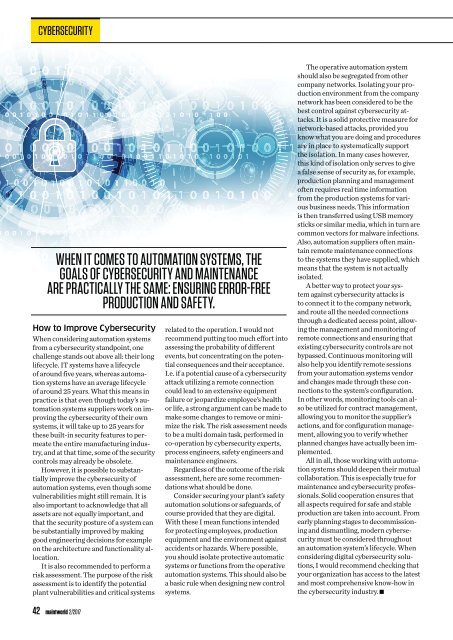Maintworld 2/2017
Create successful ePaper yourself
Turn your PDF publications into a flip-book with our unique Google optimized e-Paper software.
CYBERSECURITY<br />
WHEN IT COMES TO AUTOMATION SYSTEMS, THE<br />
GOALS OF CYBERSECURITY AND MAINTENANCE<br />
ARE PRACTICALLY THE SAME: ENSURING ERROR-FREE<br />
PRODUCTION AND SAFETY.<br />
How to Improve Cybersecurity<br />
When considering automation systems<br />
from a cybersecurity standpoint, one<br />
challenge stands out above all: their long<br />
lifecycle. IT systems have a lifecycle<br />
of around five years, whereas automation<br />
systems have an average lifecycle<br />
of around 25 years. What this means in<br />
practice is that even though today’s automation<br />
systems suppliers work on improving<br />
the cybersecurity of their own<br />
systems, it will take up to 25 years for<br />
these built-in security features to permeate<br />
the entire manufacturing industry,<br />
and at that time, some of the security<br />
controls may already be obsolete.<br />
However, it is possible to substantially<br />
improve the cybersecurity of<br />
automation systems, even though some<br />
vulnerabilities might still remain. It is<br />
also important to acknowledge that all<br />
assets are not equally important, and<br />
that the security posture of a system can<br />
be substantially improved by making<br />
good engineering decisions for example<br />
on the architecture and functionality allocation.<br />
It is also recommended to perform a<br />
risk assessment. The purpose of the risk<br />
assessment is to identify the potential<br />
plant vulnerabilities and critical systems<br />
related to the operation. I would not<br />
recommend putting too much effort into<br />
assessing the probability of different<br />
events, but concentrating on the potential<br />
consequences and their acceptance.<br />
I.e. if a potential cause of a cybersecurity<br />
attack utilizing a remote connection<br />
could lead to an extensive equipment<br />
failure or jeopardize employee’s health<br />
or life, a strong argument can be made to<br />
make some changes to remove or minimize<br />
the risk. The risk assessment needs<br />
to be a multi domain task, performed in<br />
co-operation by cybersecurity experts,<br />
process engineers, safety engineers and<br />
maintenance engineers.<br />
Regardless of the outcome of the risk<br />
assessment, here are some recommendations<br />
what should be done.<br />
Consider securing your plant’s safety<br />
automation solutions or safeguards, of<br />
course provided that they are digital.<br />
With these I mean functions intended<br />
for protecting employees, production<br />
equipment and the environment against<br />
accidents or hazards. Where possible,<br />
you should isolate protective automatic<br />
systems or functions from the operative<br />
automation systems. This should also be<br />
a basic rule when designing new control<br />
systems.<br />
The operative automation system<br />
should also be segregated from other<br />
company networks. Isolating your production<br />
environment from the company<br />
network has been considered to be the<br />
best control against cybersecurity attacks.<br />
It is a solid protective measure for<br />
network-based attacks, provided you<br />
know what you are doing and procedures<br />
are in place to systematically support<br />
the isolation. In many cases however,<br />
this kind of isolation only serves to give<br />
a false sense of security as, for example,<br />
production planning and management<br />
often requires real time information<br />
from the production systems for various<br />
business needs. This information<br />
is then transferred using USB memory<br />
sticks or similar media, which in turn are<br />
common vectors for malware infections.<br />
Also, automation suppliers often maintain<br />
remote maintenance connections<br />
to the systems they have supplied, which<br />
means that the system is not actually<br />
isolated.<br />
A better way to protect your system<br />
against cybersecurity attacks is<br />
to connect it to the company network,<br />
and route all the needed connections<br />
through a dedicated access point, allowing<br />
the management and monitoring of<br />
remote connections and ensuring that<br />
existing cybersecurity controls are not<br />
bypassed. Continuous monitoring will<br />
also help you identify remote sessions<br />
from your automation systems vendor<br />
and changes made through these connections<br />
to the system’s configuration.<br />
In other words, monitoring tools can also<br />
be utilized for contract management,<br />
allowing you to monitor the supplier’s<br />
actions, and for configuration management,<br />
allowing you to verify whether<br />
planned changes have actually been implemented.<br />
All in all, those working with automation<br />
systems should deepen their mutual<br />
collaboration. This is especially true for<br />
maintenance and cybersecurity professionals.<br />
Solid cooperation ensures that<br />
all aspects required for safe and stable<br />
production are taken into account. From<br />
early planning stages to decommissioning<br />
and dismantling, modern cybersecurity<br />
must be considered throughout<br />
an automation system’s lifecycle. When<br />
considering digital cybersecurity solutions,<br />
I would recommend checking that<br />
your organization has access to the latest<br />
and most comprehensive know-how in<br />
the cybersecurity industry.<br />
42 maintworld 2/<strong>2017</strong>

















